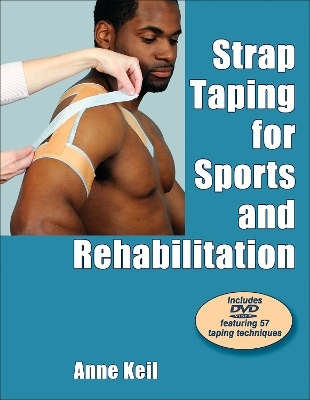
Strap Taping for Sports and Rehabilitation
Human Kinetics
978-0-7360-9527-3 (ISBN)
Strap Taping for Sports and Rehabilitation presents taping techniques for use on all body areas in both physical therapy and modified athletic training. This easy-to-use reference contains 50 strap taping techniques with Leukotape that help support or control joint mobility and provide greater stability than other methods of taping. Though the text focuses on strap taping for physical therapy, it also includes a variety of sport-related taping and other techniques used in orthopedic rehabilitation. Many of these techniques can also be used or modified for use with neurological and pediatric patients or clients.
Each taping technique is shown step by step through the use of full-color photographs. In addition, an accompanying DVD provides detailed demonstrations of all tape applications. By referring to more than 200 photos and illustrations with video sequences, readers will experience a dynamic and detailed presentation for learning strap taping techniques.
Strap Taping for Sports and Rehabilitation follows a regional approach in presenting appropriate techniques for injuries and other conditions for the ankle and foot; the knee; the cervical, thoracic, and lumbopelvic area; the shoulder; and the elbow, wrist, and hand. The text includes a discussion of the types of tape currently used in treatment and rehabilitation of injuries and presents theories on effectiveness of taping. It also details taping precautions, supplies, and guidelines for application so that readers can be confident they are applying the appropriate taping methods to suit the needs of their patients, clients, and athletes. In addition to an explanation of taping techniques, the text includes photos and illustrations of anatomical references and landmarks. Readers will find reviews of functional range of motion, current evidence on the efficacy of taping, screening tools used in determining the appropriate technique, alternative bracing techniques, and case studies illustrating the benefits of effective taping.
Strap Taping for Sports and Rehabilitation is an excellent resource for both students and professionals in physical therapy, occupational therapy, and athletic training seeking guidance in the proper selection and effective application of strap taping techniques. With full-color photos and video sequences, Strap Taping for Sports and Rehabilitation and the accompanying DVD offer readers a dynamic way to learn and review a range of taping techniques used in treating sport and orthopedic injuries.
Anne Keil, PT, DPT, is a physical therapist and supervisor of rehabilitation services at the University of Colorado Hospital at Stapleton and Park Meadows Rehabilitation Clinics in Denver. Dr. Keil has worked in a variety of areas, including outpatient orthopedics, neurology, inpatient, skilled nursing, rehabilitation, and home health care. Working in facilities or countries that did not have many physical therapy resources, Dr. Keil became interested in taping as a low-cost adjunct to treatment and an effective alternative to bracing. Dr. Keil received her doctorate in physical therapy in 2005 from Simmons College in Boston, Massachusetts. She earned her BS in physical therapy in 1991 and BS in community health science in 1989 from California State University at Fresno. Dr. Keil is a member of the American Physical Therapy Association (APTA).
Chapter 1. Introduction to Taping
Relationship Between Taping and Anatomy
Types of Tape
Why Strapping Tape?
Taping Guidelines
Taping Application
Documentation
Chapter 2. Ankle and Foot
Anatomy of the Ankle and Foot
Evidence
Orthotics
Evaluation
Techniques
Low Dye
Cross X
Navicular Lift
Subtalar Neutral Stirrup Ankle Support and Modified High Dye
Calcaneus Inversion Glide
Calcaneus: Alternative Technique
Achilles Unloading
Hypermobile Distal Fibula
Hallux Abductovalgus (HAV) Bunion Correction
First Metatarsal–Cuneiform Glide
Fifth Metatarsal Dorsal Glide
Fifth Metatarsal–Cuboid Dorsal and Plantar Glide
Gastrocnemius Unloading
Braces
Case Studies
Chapter 3. The Knee
Anatomy of the Knee
Evidence
Evaluation
Techniques
Patellar Medial Glide (Plus Tilt Corrections)
Patellar Tendon Unloading
Infrapatellar Fat Pad Unloading
Pes Anserinus Bursitis Unloading
Iliotibial Band Friction Syndrome
Proximal Fibular Glide
Tibiofemoral Torsion
Knee Hyperextension Block
Tensor Fascia Lata Glide
Medial Hamstring Unloading
Braces
Case Studies
Chapter 4. The Cervical, Thoracic, and Lumbopelvic Area
Anatomy of the Cervical, Thoracic, and Lumbopelvic Area
Evidence
Evaluation
Techniques
Postural Taping: Upper Back, Midback, and Lower Back
Thoracic Vertebra Glide
Rib Support
Low Back Hyperextension Limit
Sacroiliac Approximation
Ilial Shear, Anterior or Posterior
Diamond Box Unloading
Hip and Gluteal Muscle Approximation
Braces
Case Studies
Chapter 5. The Shoulder
Anatomy of the Shoulder
Evidence
Evaluation
Techniques
Postural Upper Back
AC Joint Separation and Clavicle Fracture Correction
AC Joint Blocking (for Subacromial Impingement)
Scapula Position Correction
Inferior Subluxing Shoulder Correction
Anterior Shoulder Dislocation Protection
Braces
Case Studies
Chapter 6. The Elbow, Wrist, and Hand
Anatomy of the Elbow, Wrist, and Hand
Evidence
Evaluation
Techniques
Epicondylitis Strapping
Radial Head Glide
Diamond Box Unloading
Ulnar External Rotation Glide
Ulnar Internal Rotation Glide
Elbow Hyperextension Varus or Valgus Laxity Block
Neutral Wrist Strapping
Wrist Flexion or Extension Block
Wrist Pain, Radiocarpal Glide
Fifth Metacarpal Dorsal Glide
Ventral Ulnar Glide
Trapezium Glide
Thumb Block
Braces
Case Studies
| Verlagsort | Champaign, IL |
|---|---|
| Sprache | englisch |
| Maße | 216 x 279 mm |
| Gewicht | 658 g |
| Themenwelt | Sachbuch/Ratgeber ► Sport |
| Medizin / Pharmazie ► Medizinische Fachgebiete ► Sportmedizin | |
| Medizin / Pharmazie ► Physiotherapie / Ergotherapie | |
| ISBN-10 | 0-7360-9527-6 / 0736095276 |
| ISBN-13 | 978-0-7360-9527-3 / 9780736095273 |
| Zustand | Neuware |
| Informationen gemäß Produktsicherheitsverordnung (GPSR) | |
| Haben Sie eine Frage zum Produkt? |